Sebaceous carcinoma: Deadly eyelid tumor
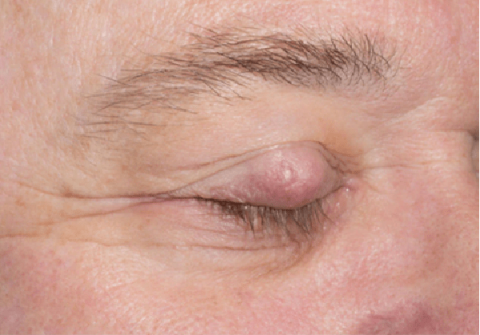
Sebaceous carcinoma is a rare cancer in the world, with a relatively rapid progression. The main site affected by this disease is the eyelids. This type of cancer is difficult to diagnose for several reasons. Let's learn about this cancer.
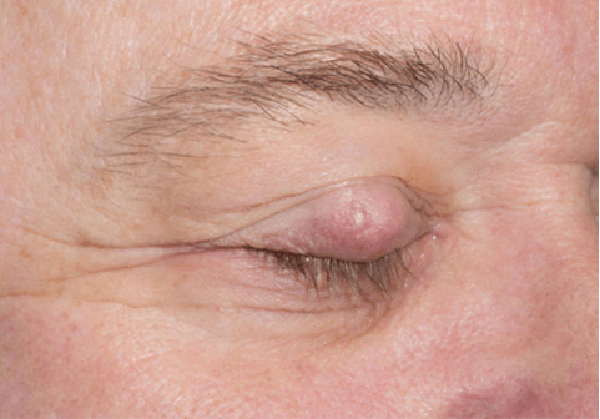
Sebaceous gland tumor in the upper eyelid of the eye.
content
- 1. Introduction:
- 2. Presence of sebaceous carcinoma:
- 3. Causes and risk factors:
- 4. Symptoms of sebaceous carcinoma:
- 5. Diagnosis of sebaceous gland cancer.
- 6. Outcomes of patients with sebaceous carcinoma.
- 7. Treatment:
- 8. Conclusion:
1. Introduction:
Sebaceous carcinoma as the name implies, is a type of malignant tumor.
Cancer:
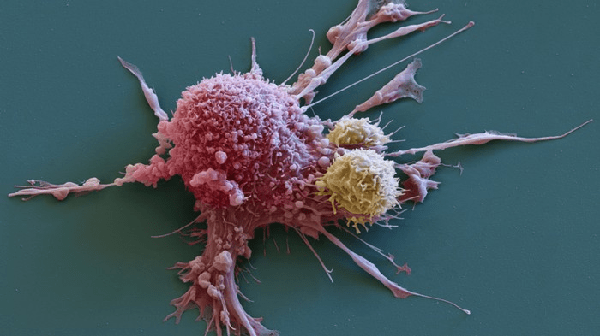
Illustration of cancer cells
Cancer is a term that describes certain cells that have the ability to grow and divide continuously, uncontrollably by the body. Unlike normal cells that will die on their own after a certain period of time, cancer cells can in some respects be considered as immortal cells.
Therefore, from a cancer cell, it can develop into a tumor on its own, as well as the tumor will grow on its own.
The next possibility is that the cancer can enter the blood vessels to reach other organs. This phenomenon is called metastasis.
The invasion, uncontrolled growth of cancer will compress and disrupt the function of the organ it goes to.
Cancer also requires the body to supply blood and nutrients to nourish them. From there, cancer takes over the life of nearby organs.
Epithelium:
Includes skin cells, cells that line the inside or cells that cover the outside of the body's organs.
Skin cancer, cervical cancer, anal cancer, esophageal cancer, liver cancer, larynx cancer, kidney cancer, stomach cancer, various types of testicular cancer, thyroid cancer, and sebaceous gland cancer … These cancers are all carcinomas.
Sebaceous glands:
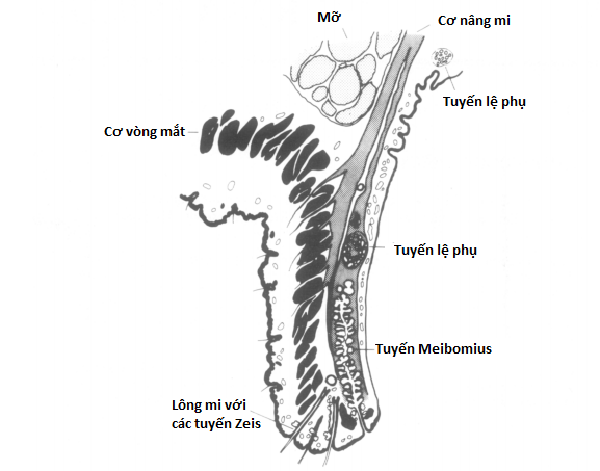
Longitudinal image of eyelid and sebaceous gland structures (Meibomius, Zeis), lacrimal gland in eyelid.
Sebaceous glands are present everywhere on the body, except for the palms of the hands and soles of the feet. They exist together with the hair follicles hence the other name hair follicle-sebaceous glands. These structures have ducts that lead to the surface of the skin.
Types of sebaceous glands:
- In the lips are the Fordyce glands.
- In the penis is the Tyson gland.
- The breasts have Montgomery glands.
- The eyelids are Meibomian glands, Zeis glands (as shown above).
Sebaceous glands in the face, chest, back, and outer arm are the largest and most numerous compared to other locations.
Sebaceous glands secrete substances called sebum. These substances go out through ducts directly from the sebaceous glands.
The role of sebum:
- Helps soften skin.
- Not waterproof
- Limit the entry of bacteria from the outside environment.
Thus, sebaceous carcinoma is a type of cancer that affects the entire sebaceous glands throughout the body. The most common location is from the trunk upwards and mainly on the eyelids.
Therefore, we can call this disease with another name, eyelid cancer.
2. Presence of sebaceous carcinoma:
Sebaceous carcinoma can appear anywhere in the body. Except for the palms and soles of course.
75% of sebaceous carcinomas are located in the eyelids.
In the United States, of all types of eyelid tumors, both benign and malignant, the rate of sebaceous carcinoma of the eyelid accounts for about 1% and is only 1 in 1 million people diagnosed each year.
Sadly, this number is so high in the general Asian population. Up to 1/3 of cases of yellow-skinned people with eyelid tumors are sebaceous gland cancers!!!
3. Causes and risk factors:
It is not known what the actual cause of sebaceous carcinoma is.
It is suspected that genetic mutations may be one of the key driving factors. This problem is raised because radiation therapy for facial cancer in children increases the risk of developing eyelid cancer.
See more detailed reference articles about Eyelashes: The protective barrier and beauty of the eyes .
Immunodeficiency due to HIV/AIDS also increases the risk of this malignancy.
Patients with eyelid cancer are mainly the elderly 60-80 years old. However, this condition can appear at any point in life. The youngest age of infection ever recorded was 3 years old.
Women are affected more often than men by a ratio of about 3/2. Asians are 6.2 times more susceptible than Europeans and Americans.
4. Symptoms of sebaceous carcinoma:
In this article, we mainly write about sebaceous carcinoma of the eyelids – the most common location.
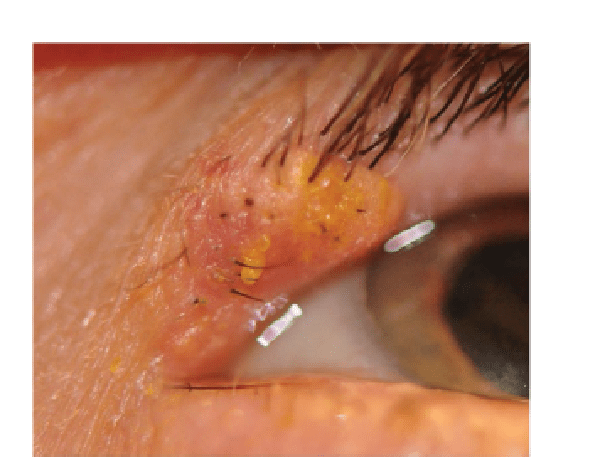
Typical picture of a sebaceous carcinoma of the eyelids.
The main symptom is the presence of a small nodule, which gradually enlarges (at a very slow rate). This nodule is hard and deep inside the eyelid (the doctor will determine this).
The nodule is the shape corresponding to the cancer in the Zeis gland.
Cancer in the Meibomian gland is plaque.
When nodular lesions are present , it can be difficult to distinguish cancer from another benign sebaceous gland disease of the eyelids, chapped .
Chafing occurs mainly due to blockage of the sebaceous ducts of the sebaceous glands. This disease causes the sebaceous glands to fill with oil and swell. Usually, the chalazion swells for about 2-8 weeks, rarely longer, and is painless to palpation .
Chalazion is the most common pathology to be confused with sebaceous carcinoma of the eyelids.
Blepharitis is the primary differential disease if it is a cancer of the Meibomian gland. The common manifestation of these two diseases is the appearance of hard plaques on the upper eyelids . Blepharitis is an infection of the eyelid margin. It is also known as Meibomian gland inflammation, and it causes pain .
Two-thirds of eyelid cancers occur in the upper eyelid because the upper eyelid has more sebaceous glands than the lower eyelid.
Swollen eyes are also one of the common eye diseases. It usually looks like a small yellow pus-like spot on the edge of the eyelid. See more articles about Eye styes and what you need to know to prevent them!
5. Diagnosis of sebaceous gland cancer.
Cancer is generally diagnosed primarily by biopsy of the lesion.
Biopsy is the use of a scalpel to cut the entire nodule or use a fine needle to aspirate a few cells, then observe under a microscope.
During a biopsy, your doctor will need to take multiple samples (multiple needle punctures in the eyelid area) because this cancer can arise from many sebaceous glands at the same time in the eyelid area.
Sadly, the diagnosis of this pathology is often delayed!!!
The reason for this regret is:
- This type of cancer is rare.
- There are too many pathologies that are similar in appearance and are more common than sebaceous carcinoma. This makes the examining doctor subjective.
- The main symptom is simply a small nodule on the eyelid, rarely causing pain, slow skin progression. Therefore, patients are often subjective and do not go to the doctor.
Because of these problems, doctors need to ask the patient and examine them carefully for small tumors in the eyelid area.
Emphasizing that the rate of eyelid cancer in Asians is significantly higher than the world average.
6. Outcomes of patients with sebaceous carcinoma.
This is a malignant cancer. It has a chance of local recurrence within 5 years after surgery with a rate of 9-36%. “Local recurrence” means that after complete resection of the tumor, after 5 years, the tumor can reappear in the same place.
Eyelid cancer can spread to blood vessels, from where it travels to the liver, lungs, brain, bones, as well as nearby lymph nodes.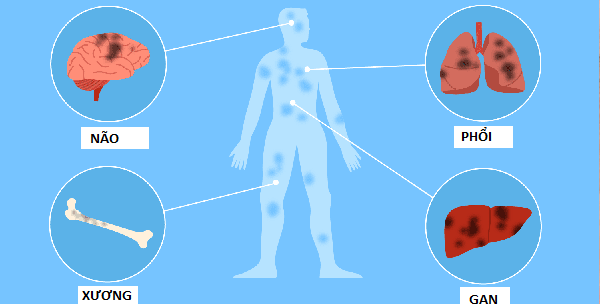
Liver, lung, brain and bone are the common metastatic organs of eyelid cancer. In addition, eyelid cancer has metastasized to nearby lymph nodes.
The patient's risk of dying is significantly increased when the cancer has spread to the organs pictured.
When diagnosed, 14-25% of cases already have metastases. The mortality rate at this time is about 50-67% after 5 years from the appearance of the tumor.
If the tumor has not metastasized, people rely on size to determine the mortality rate:
- Tumor <6mm: billion="" ratio="" death="" death="" is="">
- 6 – 10mm is 18%.
- 11 - 20mm is 50%.
- >20mm is 60%.
The mortality rate increases because the larger the size, the greater the possibility of metastasis of the tumor.
7. Treatment:
Treatment for sebaceous carcinoma usually includes surgery to remove the cancer. Sometimes additional treatment with chemotherapy or radiation is required.
Treatment of this condition often requires the cooperation of dermatologists, eye doctors, and oncologists.
Experts in other fields may also be involved, depending on your situation.
Treatment options usually include:
Surgery to remove cancer
Your doctor may recommend removing the cancer and some surrounding normal cells!!! It may sound bizarre, but the truth is that this method reduces the chances of cancer cells being eliminated.
Usually the type of surgery of choice is Mohs.
Mohs surgery is a special type of surgery. The doctor will gradually remove thin layers of skin that contain cancer cells until only cancer-free tissue remains.
To ensure this, people will check for signs of cancer on each layer of skin during surgery. In other words, having just finished a layer of cells, the surgery is to stop for a while to bring the cells for testing, and then to operate the next layer.
This process will be repeated until there are no signs of cancer, then the surgery is over.
Radiotherapy
Radiation therapy is a treatment that uses beams, such as X-rays and protons. By shooting these rays directly at the tumor, the cancer cells are destroyed.
For sebaceous carcinoma, radiation therapy may be used alone or may be used after the patient has had surgery.
The goal of radiation therapy after surgery is to destroy any remaining cancer cells. The remnants of cancer cells after surgery are sometimes unavoidable, especially when the cancer has penetrated so deeply into the underlying tissue that no scalpel can enter. At this time, radiation therapy is an appropriate rescue method.
With these two methods, the average 5-year survival rate of patients is 96%. Of course, this number depends on the specific tumor size, invasion, and metastasis of each patient.
Valence
Usually when the tumor has spread to other organs, chemotherapy is performed.
8. Conclusion:
Sebaceous gland carcinoma – also known as eyelid cancer. It is a rare disease in the world but not uncommon in Asians.
The cause of the disease is still unclear, the symptoms are easy to see but difficult to diagnose. Many benign causes have similar manifestations. As a result, a delayed diagnosis of up to two-thirds of cases has been reported.
Patient survival depends on the size and invasion of the tumor. The main method of treatment is surgery. Radiation or chemotherapy depends on the individual case.
Doctor NGUYEN DOAN TRANG NHAN